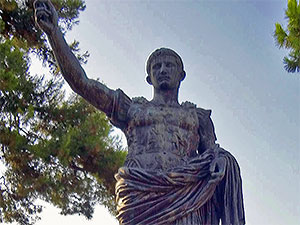


ChessBase 17 - Mega package - Edition 2024
It is the program of choice for anyone who loves the game and wants to know more about it. Start your personal success story with ChessBase and enjoy the game even more.

In Italy, numerous smaller cities hide great beauty as well as historical and cultural treasures but remain obscured by the world fame of their grander counterparts like Rome, Florence or Venice. One such jewel is Fano, a commune of the province of Pesaro and Urbino in the Marche region on the South East Adriatic Coast.
Fano offers both a seaside with sandy or pebbled beaches and an Old Town dating to the Roman times of Emperor Augustus’s reign.

A summer scene of Fano’s beach, seen from my ‘room with a view’ of the simple but splendid and hospitable 3-star hotel ‘Continental’.

The Roman gate – 'Arco d’Augusto' (Augustus' Arch). On the left, a statue of Augustus can be discerned in the shade.
It was at Fano that the famous Via Flaminia, the road departing from Rome, would reach the Adriatic Sea, ending exactly at the entrance of the Augustus Arch.

Detail of the Augustus arch, with its original inscription, which contains the dedication ‘PATER PATRIAE MURUM DEDIT’ – ‘The Father of the Country edified this wall’.

Augustus Caesar, the founder of Fanum Fortunae
Fanum Fortunae was Fano’s original name. It was a sacred centre during the Roman epoch with a temple dedicated to the cult of Fortuna, the goddess of fortune, who in the Roman religion was worshipped and feared for the luck she might bring – either good or bad.

A corner of the City Wall built by Augustus, decorated later with a coat of arms of Pope Julius III
Underneath the Fano of today, long corridors hide beautifully preserved remnants of the Roman city of over 2000 years ago. Archaeologists have discerned dwellings, palaces, narrow streets, baths and complex water and refuse systems.

A detail of a huge area of Roman remnants that lie underneath contemporary Fano

The Palace of Reason built in the 13th century in Romanesque-Gothic style and a fountain built in the 17th century dedicated to the Goddess of Fortune, in the main square, Piazza XX Settembre.
The renaissance and baroque periods also left indelible marks in Fano. The arts and architecture were flourishing sponsored by the region’s rich families like Malatesta, Borgia and della Rovere.

The Gothic surface of the Malatesta palace (Corte Malatestiana), which today hosts the collection of the Archaeological Museum.

An artefact in the Archaeological Museum – a mosaic from the Roman era

Next to a Roman urn is Manuela Palmucci, a knowledgeable guide of her native city, who over a couple of days revealed to me the secrets of both the above and the subterranean Fano.
In Fano’s churches and palaces are found masterpieces by Renaissance and Baroque artists including Guido Reni, Perugino, Guercino, Caracci, and the young Rafael who was born in the neighbouring town of Urbino.

The Cathedral (12th century)

Altarpiece depicting the Virgin by Perugino with a predella attributed to the young Rafael, in the Church Santa Maria Nuova (1521).
‘The delivery of the key’, a masterpiece by Guido Reni (1575-1642), a representative of the peak of the Italian baroque, has been expatriated during the Napoleonic wars and housed at the Louvre ever since. It was returned home for a temporary exhibition at the Fano’s Pinacoteca San Domenico.

Gudo Reni: ‘The delivery of the key’ in the middle, flanked by two versions of the ‘Annunciation’
And Fano has a carnival, too, the oldest in Italy, whose aim is to ridicule public figures presenting them in sculptural caricatures. In the current European climate, former Italian Prime ministers Berlusconi (on the left) and Monti, and the German chancellor Angela Merkel were obvious targets.

Carnevalesque caricature of Berlusconi, Monti and Merkel
Photos by Diana Mihajlova
To be continued...
LinksYou can also use ChessBase 12 or any of our Fritz compatible chess programs to replay the games in PGN. You can also download our free Playchess client, which will in addition give you immediate access to the chess server Playchess.com. |